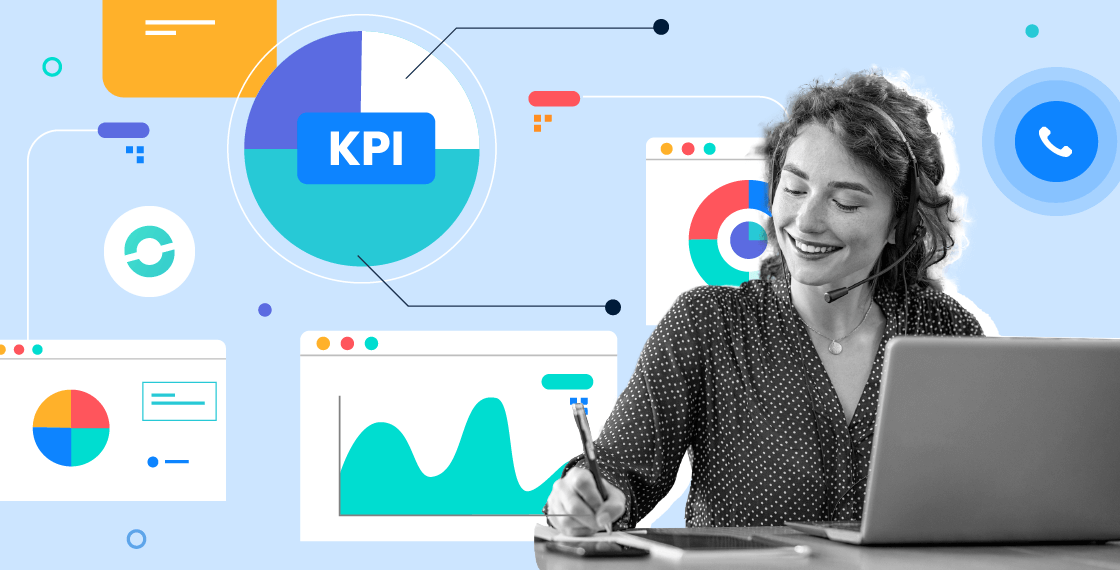Summary
There might be dispute over who said it first, but it remains as true as ever: what gets measured, gets managed. This applies in the call centre as much as anywhere else.
To understand whether this vital department is fulfilling its objectives and serving both your customers and your bottom line effectively, you have to keep an eye on a range of different call centre KPIs. The good news is that modern business phone systems like Ringover make this data easy to gather and analyse in real time, so you can take prompt action if required.
By combining and comparing the different metrics, you’ll be able to identify where the problem lies, and take the right steps to make things better as needed.In this article we’ll explore the top 20 call centre metrics to measure in your call centre to measure these 3 major elements:
Top 20 Call Centre KPIs To Monitor in 2025
These metrics can be impacted by many factors including the product itself, but your call centre is all about delivering customer satisfaction. Exactly how that is going can be monitored by keeping a close eye on the following metrics:
1. CSAT (Customer Satisfaction score)
The simplest way to find out how satisfied your customers are is to ask them — and a quick exit survey will give you running feedback on how you are doing, and how this alters over time will provide a valuable indicator of overall happiness.
You could use a Likkert (numerical) scale, or a simple “very satisfied, satisfied, not satisfied, very dissatisfied’ rating score, or get flashy with sliders etc… Two important things to remember: Ask everyone, because the only spontaneous feedback you will get is likely to be extreme (and frequently negative).
And if you change the presentation or wording of the scale, for example to try and increase response rate, then you won’t have meaningful comparisons to be made between the data — so avoid doing this too often.
2. Net Promoter Score® (NPS®)
This rating has some complex arithmetic behind it, but ultimately comes down to a score, expressed as a rating out of 10 (occasionally 100), which answers the question “how likely are you to recommend our company to your friends/colleagues?” This score is very useful as it’s extremely quick for respondents to engage with — they just have to click a number, in a customer survey — and because it’s an externally validated formula, it lets you make meaningful comparisons with other brands and products, as well as comparing with your own performance over time. A positive NPS (>0) is generally considered as good.

3. First Contact Resolution (FCR)
Fixing your customers’ problems fast is a great way to ensure their satisfaction, and the proportion of calls which can be resolved in a single contact reflects a great many factors, including your agent’s skill and experience, as well as any issues with the product itself.
When customers have to be called back, or worse still make multiple contacts themselves because of ongoing problems, this contributes to churn and abandonment — so it’s vital to make people happy the first time.As such it’s an important factor to stay on top of and monitor for any changes, and you can track successful resolution over the total number of calls, or resolution over the total number of first calls (just be consistent), to ensure that your standards are maintained.
4. Call abandonment rate
One way to ensure a really unhappy customer is to not respond to them in the first place — so careful monitoring of your call abandonment rate is essential, to make sure inbound callers are not giving up in the first place.
Of course every caller has their unique expectations and threshold of patience, but averaging out this will tell you a great deal about how satisfied they are as a cohort, and also provide valuable insight into your call centre management and your product status: If call abandonment rate increases, do you need to hire more agents? Or run more shifts temporarily to coincide with a new release or update that is creating a wave of inquiries?Keep an eye on this metric, because any customer who is unable to reach you will likely take their business elsewhere, and may well vent their frustration in a public way.
5. Customer Churn Rate (CCR)
CCR measures the proportion of customers that have stopped using your service in a given period. It’s the mirror image of Customer Retention Rate (CRR), and shows you the speed at which customers are dropping off from using your product or service.
It’s important to use this data in conjunction with other business intelligence such as your customer acquisition cost, so you understand the benefits of reducing churn vs attracting new customers overall (usually it’s more efficient to hang on to the customers you have, but not always).
6. Longest hold time rate (LTR)
Before a customer joins the abandonment statistics or finally gets responded to, one of them will win the unlikely prize of having had the longest time to wait. It doesn’t matter who this person is, but how long they held on is important. You want to keep this metric to a minimum, because they are right next to being a lost lead or frustrated complainer.
7. Customer call frequency
Your customers should love your brand, but they shouldn’t be your best friends, calling you regularly for a chat! Their satisfaction should mean they can manage their use of your products just fine for the vast majority of the time.
However, there will always be some who have additional or unusual support needs, so keeping an eye on your regular callers will help you manage them with greatest efficiency and keep them happy, with growing self-sufficiency over time.
This KPI therefore tells you how often the same caller rang you in a given period of time and can be expressed as an average used to estimate how many calls it takes to resolve an issue with the same person.
8. Adherence to Schedule
You’re paying your agents to be on the phone talking to your customers, so an efficient one will be minimising time between calls and picking up fast. When this score slips customers are left hanging and abandonment and missed calls go up, so it’s vital that your call centre as a whole maintains high adherence to the job of responding on the phone.
This score can also provide valuable comparisons between agent performance, as well as individual improvement over time (for a new agent, the after-call work may take longer to complete, so you’d expect their fee-earning time to increase as a proportion post on-boarding). You can track this by adding their time on calls to their total available time, dividing by the hours they are paid to work. This metric is closely related to:
9. Agent utilisation score
This quick sum will tell you the average proportion of time spent handling calls in a given shift, and is generated by dividing time on the phone by the total time of the working day. Again this is a useful way to track performance improvements over time, as well as to compare between different agents or teams.
10. Average Speed of Answer
The call abandonment rate (see above) is of course directly related to how quickly your agents pick up that phone. No one likes to be left waiting, and while you can use your IVR to inform and entertain customers yet to be attended to, reducing your response time is the best way to ensure their needs are met in a timely and effective way.Knowing your maximum acceptable threshold here can inspire agents, as well as empowering managers to bring on additional staff where needed.
11. Average After Call Work (ACW) Time/Call Wrap-up Time
After every call an agent will need to do some admin, as well as a mental reset before engaging with the next incoming query. Monitoring this metric will help you identify whether your admin can be streamlined more effectively, to minimise the amount of data which has to be hand entered — as opposed to captured directly from your call logs.
It will also highlight any agents who have difficulty with focus and concentration, who are likely to drop out of the zone and get distracted between calls, and need extra help or motivation to become more efficient.
A high value for this KPI indicates that the agents spend too much time completing tasks at the end of calls and not enough time handling calls and resolving queries. It may also imply the need to review and tweak call standard guidelines to help reps better manage their overall call handling methods.
12. Average handle time
The time needed for each call can be seen as the time spent on the call itself, the time the customer is waiting, and the after work admin done.
When this is analysed by agent as a function of their total number of calls handled, you can compare agent efficiencies directly.Who is ‘cooking with gas’, and getting stuff done? You will want to reward these high performers appropriately, and look at training and support needs for those who always take longer to handle each call.

13. Agent attrition rate
Your customer service agents are customers too, and their satisfaction matters — so you need to provide an effectively rewarded and motivated working environment. The agent attrition rate, i.e. the rate at which staff quit, can tell you a lot about morale in your call centre.
Quite apart from the direct costs of recruitment and retention, losing experienced staff will impact other metrics such as first call resolution, and a high turnover rate is likely to suggest you are not operating a happy and enthusiastic workplace where people are motivated to do their best.
14. Occupancy rate
This is another way of viewing your agent efficiency, in terms of what proportion of their time is occupied on calls — compared with their total time on the shift you’re paying for, which includes breaks, training sessions, and individual inefficiencies and habits. This simple metric will let you compare agents individually, as shifts, or as teams.

15. Total calls
As obvious as it sounds, but still important, to consider in context with other metrics. Your agents can’t do their job, if calls are not coming in — so that might be a job for marketing or product, to ensure your resourcing levels are aligned adequately.
Conversely, your call centre might look bad in terms of factors like abandonment if total calls suddenly escalate unexpectedly, and the best agents in the world simply cannot respond fast enough. There are many moving parts to an effective call centre, and this metric is easy to overlook.
16. Service level
You can monitor your total efficiency in a number of ways, but typically it will be a function of calls answered within a designated target time, divided by the total number of incoming calls.
The number of abandoned calls can be added to the total calls, and the whole thing multiplied by 100 to express it as a percentage. The important thing is to measure it consistently, and to be right on top of any reductions in the service level — this could happen for a number of reasons, but you will need to understand it and fix it fast.
17. Percentage of calls blocked
With a Ringover phone system correctly configured, your inbound callers should never reach a busy signal — the IVR should guide them appropriately to the right destination, without any human or automated resources becoming overwhelmed.
Budget and efficiency considerations will be a factor, but an eye on this metric will tell you what you need to fix so that your callers never again stumble upon a busy tone and how to stop it happening altogether.
18. Peak hour traffic
Do you know when your agents are going to be busiest? If you’re not monitoring when the inbound calling happens, you won’t be able to staff up accordingly, and that can lead to more call abandonment and blocked calls, all of which escalates dissatisfaction.
Monitoring your peak hour traffic, or call arrival rate, will put you in control, and also provide insight for the rest of the organisation (if unexpected peaks or troughs signify, for example, issues with a recent product update).
19. Forecasting accuracy
The above numbers will help you to ensure your call centre is acting at its maximum potential, and whether you forecasted resource usage effectively — from the number of agents to endpoints to shift length.
A call centre’s efficiency is only ever as good as its managers and their ability to make the best use of all the resources they have at hand, to best tread that careful balance between customer satisfaction, managing costs, and maximising opportunity.
Forecast accuracy therefore shows the difference between actual and forecasted business performance and takes into account the change variation in performance over set intervals. For example, one can measure forecast accuracy on the number on call handling time using 15 minute intervals per day.
20. Cost per call (CPC)
At the end of the day, the money is what matters. And whether you are optimising your call centre management for the ultimate white glove satisfaction of luxury goods customers or high-end enterprise clients, or maximising throughout without churn for volume, then you need to know exactly what each call costs you directly.
Your CPC will illustrate how much of an impact your agents’ calls are having to your bottom line. The lower the value the better of course but remember that this average may disguise considerable individual variance — but being aware of any trends up or down will reward you well, when it comes to the bottom line.
Data is the new oil, but insight is gold...
So many metrics to monitor, but Ringover makes it easy to stay on top of the numbers. What you do with that insight is where the magic happens, and your data and analytics transforms into business intelligence, with input from sales, marketing, innovation, and other departments. But the input from your call centre will help all of these stay on track where the rubber meets the road, and your products meet their most important stakeholders: your customers.
Need more information on call centre metrics?
Contact our experts to help guide you step-by-step at +44 20 3808 5555 or send an email to [email protected]. Sign up for a free trial and be up and running within minutes.
Published on August 19, 2024.

